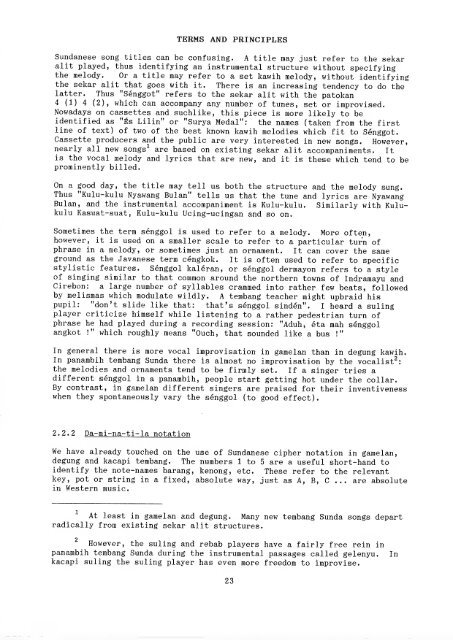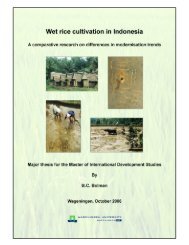Guide to Sundanese Music - Free EBooks Library
Guide to Sundanese Music - Free EBooks Library
Guide to Sundanese Music - Free EBooks Library
You also want an ePaper? Increase the reach of your titles
YUMPU automatically turns print PDFs into web optimized ePapers that Google loves.
TERMS AND PRINCIPLES<br />
<strong>Sundanese</strong> song titles can be confusing. A title may just refer <strong>to</strong> the sekar<br />
alit played, thus identifying an instrumental structure without specifying<br />
the melody. Or a title may refer <strong>to</strong> a set kawih melody, without identifying<br />
the sekar alit that goes with it. There is an increasing tendency <strong>to</strong> do the<br />
latter. Thus "Senggot" refers <strong>to</strong> the sekar alit with the pa<strong>to</strong>kan<br />
4 (1) 4 (2), which can accompany any number of tunes, set or improvised.<br />
Nowadays on cassettes and suchlike, this piece is more likely <strong>to</strong> be<br />
identified as "ts Lilin" or "Surya Medal": the names (taken from the first<br />
line of text) of two of the best known kawih melodies which fit <strong>to</strong> Senggot.<br />
Cassette producers and the public are very interested in new songs. However,<br />
nearly all new songs^ are based on existing sekar alit accompaniments. It<br />
is the vocal melody and lyrics that are new, and it is these which tend <strong>to</strong> be<br />
prominently billed.<br />
On a good day, the title may tell us both the structure and the melody sung.<br />
Thus "Kulu-kulu Nyawang Bulan" tells us that the tune and lyrics are Nyawang<br />
Bulan, and the instrumental accompaniment is Kulu-kulu. Similarly with Kulukulu<br />
Kasuat-suat, Kulu-kulu Ucing-ucingan and so on.<br />
Sometimes the term senggol is used <strong>to</strong> refer <strong>to</strong> a melody. More often,<br />
however, it is used on a smaller scale <strong>to</strong> refer <strong>to</strong> a particular turn of<br />
phrase in a melody, or sometimes just an ornament. It can cover the same<br />
ground as the Javanese term cengkok. It is often used <strong>to</strong> refer <strong>to</strong> specific<br />
stylistic features. Senggol kaleran, or senggol dermayon refers <strong>to</strong> a style<br />
of singing similar <strong>to</strong> that common around the northern <strong>to</strong>wns of Indramayu and<br />
Cirebon: a large number of syllables crammed in<strong>to</strong> rather few beats, followed<br />
by melismas which modulate wildly. A tembang teacher might upbraid his<br />
pupil: "don't slide like that: that's senggol sinden". I heard a suling<br />
player criticize himself while listening <strong>to</strong> a rather pedestrian turn of<br />
phrase he had played during a recording session: "Aduh, eta mah senggol<br />
angkot !" which roughly means "Ouch, that sounded like a bus !"<br />
In general there is more vocal improvisation in gamelan than in degung kawih.<br />
In panambih tembang Sunda there is almost no improvisation by the vocalist^:<br />
the melodies and ornaments tend <strong>to</strong> be firmly set. If a singer tries a<br />
different senggol in a panambih, people start getting hot under the collar.<br />
By contrast, in gamelan different singers are praised for their inventiveness<br />
when they spontaneously vary the senggol (<strong>to</strong> good effect).<br />
2*2.2 Da-mi-na-ti-la notation<br />
We have already <strong>to</strong>uched on the use of <strong>Sundanese</strong> cipher notation in gamelan,<br />
degung and kacapi tembang. The numbers 1 <strong>to</strong> 5 are a useful short-hand <strong>to</strong><br />
identify the note-names barang, kenong, etc. These refer <strong>to</strong> the relevant<br />
key, pot or string in a fixed, absolute way, just as A, B, C ... are absolute<br />
in Western music.<br />
At least in gamelan and degung. Many new tembang Sunda songs depart<br />
radically from existing sekar alit structures.<br />
However, the suling and rebab players have a fairly free rein in<br />
panambih tembang Sunda during the instrumental passages called gelenyu. In<br />
kacapi suling the suling player has even more freedom <strong>to</strong> improvise.<br />
23








